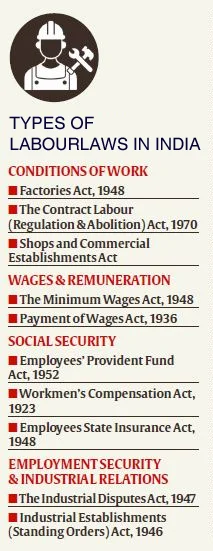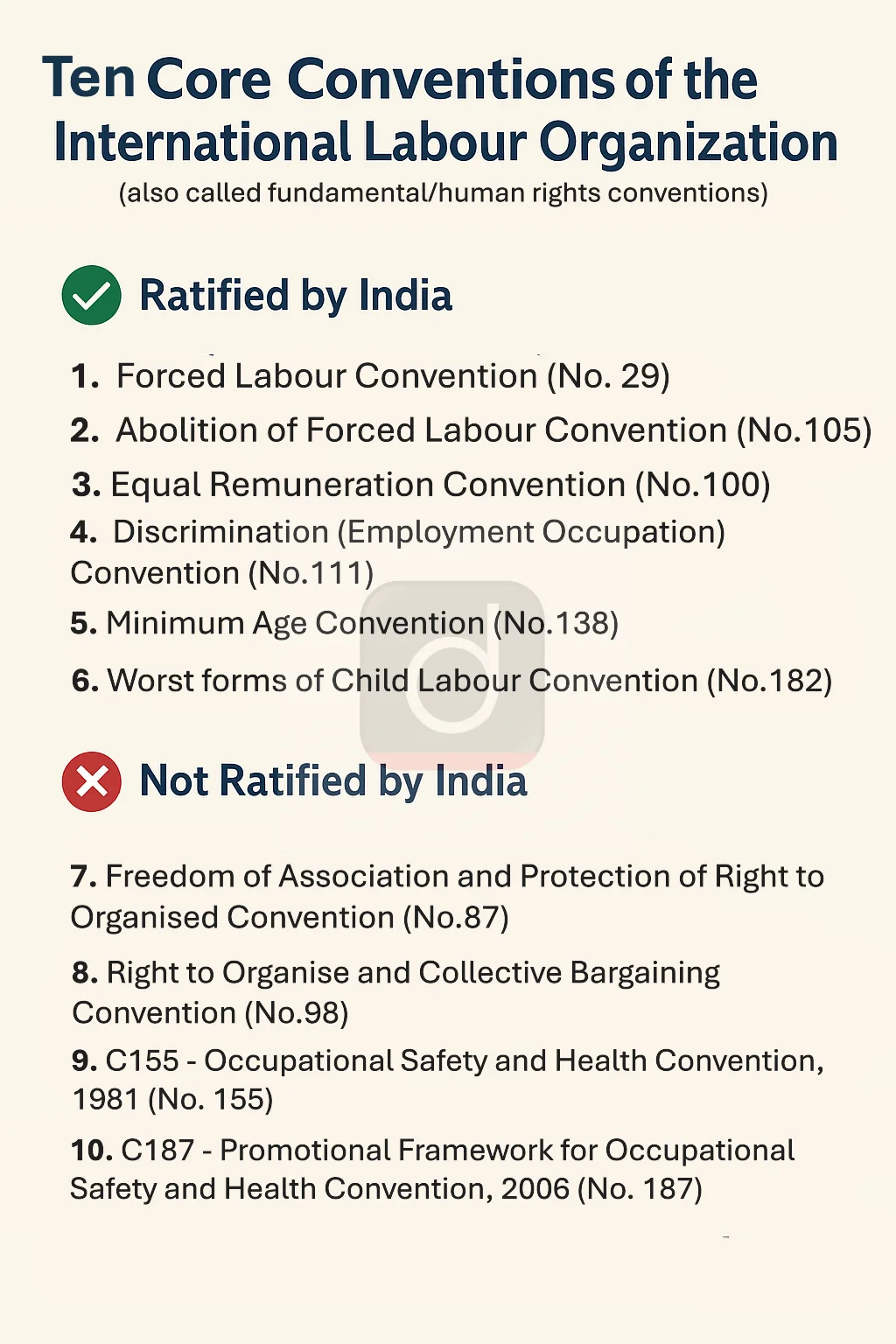Governance
Strengthening Labour Rights in India
- 13 Oct 2025
- 10 min read
For Prelims: International Labour Organization, Pradhan Mantri Shram Yogi Maan-dhan, National Skill Development Corporation
For Mains: Labour Rights and Industrial Safety in India, Challenges in Enforcement of Labour Laws, Informal Sector and Social Security Measures
Why in News?
The Sigachi Industries reactor blast in Telangana, along with a spate of industrial accidents in 2025, has reignited concerns over industrial safety standards and the weakening of labour protections, reviving debates on the erosion of workers’ rights in India.
What are the Reasons for Rising Industrial Accidents in India?
- Negligence and Cost-Cutting: Employers often ignore maintenance, use outdated machinery, and skip safety checks leading to frequent industrial accidents.
- The International Labour Organization (ILO) states that industrial accidents are rarely random and they usually result from employers cutting corners, underinvesting in safety, or forcing workers into long hours and high pressure due to low wages.
- Lack of Training and Safety Systems: Workers are poorly trained, and many sites lack alarms, safety gear, or emergency facilities leading to mishandling of equipment and delayed response during crises.
- At Sigachi Industries, the reactor reportedly ran at twice the permissible temperature without any alarm or intervention, underscoring serious safety lapses.
- Overwork and Fatigue: Long hours and high work pressure increase mistakes in hazardous environments.
- Weak Law Enforcement: Irregular inspections and poor enforcement allow unsafe practices to continue.
- Unregistered Workers: Informal workers lack records, legal protection, and access to compensation, increasing vulnerability.
- Deliberate Actions to Claim Insurance: Some accidents are manipulated or exaggerated to secure insurance payouts, contributing to underreporting of actual workplace safety practices.
What are the Key Labour Laws Governing Workers' Rights in India?
- Factories Act, 1948: Governs working conditions, machinery maintenance, safety standards, working hours, rest breaks, canteens, and crèches.
- Includes provisions for inspections and enforcement to ensure compliance.
- It was amended in 1976 and 1987, the latter after the Bhopal Gas Tragedy, to strengthen safety norms.
- Workmen’s Compensation Act, 1923: Provides compensation to workers injured or killed on the job.
- Employees’ State Insurance (ESI) Act, 1948: Offers health insurance, medical care, and cash benefits to employees in case of sickness, maternity, or employment-related injury.
- Payment of Wages Act, 1936 and Minimum Wages Act, 1948: Ensure timely and fair payment.
- Industrial Disputes Act, 1947: Protects workers’ rights regarding termination, layoffs, and dispute resolution.
- Occupational Safety, Health and Working Conditions (OSHWC) Code, 2020: Consolidates 13 previous labour laws into a single framework. OSHWC Code seeks to regulate safety, health, and working conditions across sectors, though full implementation is pending.
What are the Challenges in Protecting Workers’ Rights in India?
- Systemic Erosion of Legal Safeguards: Labour protections have been diluted under the guise of flexibility and ease of doing business, weakening enforcement mechanisms.
- For example, Maharashtra’s 2015 self-certification rule allowed factories to bypass independent inspections, undermining statutory safety provisions.
- Normalization of Informality and Vulnerability: Policy shifts favoring employer discretion to hire, fire, and extract work without oversight have entrenched informal employment, leaving workers unregistered and without legal or social protection.
- Most contract workers in Sivakasi fireworks factories operate without formal records, making accident compensation irregular and delayed.
- Gendered Exclusion from Economic Gains: Weak enforcement of workplace rights disproportionately affects women, constraining participation and perpetuating gender exclusion
- Corporate Accountability Deficit: Reduced inspections and self-certification limit avenues to hold employers criminally or financially responsible for negligence.
- For instance, industrial disasters like the Ennore coal-handling collapse saw minimal legal consequences for structural failures despite evident lapses.
- Long-Term Economic and Productivity Impact: Unsafe and exploitative work conditions lower productivity, with informal trade workers earning USD 5/hour, nearly half the national average of USD 11/hour, undermining India’s Viksit Bharat 2047 goals.
How can India Strengthen Worker Rights and Improve Safety?
- Reinforce Legal Safeguards: Fully implement the OSHWC Code, 2020, and align labour policies with ILO conventions on workplace safety, decent work, and social protection.
- Formalisation and Social Security: Digitally register informal workers through the Shram Suvidha Portal and integrate them into universal social security coverage, including pensions, health insurance, and paid leave.
- Expand the Pradhan Mantri Shram Yogi Maan-dhan (PM-SYM) pension scheme to cover all informal trade workers.
- Skill Development and Safety Training: Implement sector-specific safety and skilling programs via National Skill Development Corporation (NSDC) and Skill India Mission.
- Accelerate the implementation of Mission Digital ShramSetu as proposed by NITI Aayog.
- Leverage AI-enabled monitoring and predictive tools under #AIforAll to track compliance and hazards in high-risk industries.
- Gender-Inclusive Measures Promote female workforce participation through workplace childcare facilities, maternity benefits under the Maternity Benefit Act, 1961, and vocational training programs targeted at women in informal sectors.
- Corporate Social Responsibility (CSR) Compliance: Encourage adherence to Environmental, Social, and Governance (ESG) criteria among businesses.
- Integrate worker welfare considerations into corporate CSR strategies.
- Promote Collective Action and Safety Culture: Encourage collective bargaining, worker representation, and whistleblower protection.
- Foster a “safety-first” industrial culture, treating worker protection as an investment rather than a cost.
- Data-Driven Monitoring: Establish national dashboards to track compliance, accident rates, and social protection coverage, enabling targeted policy interventions and preventing negligence.
Conclusion
Protecting worker rights needs strong laws, social security, skills training, gender inclusion, corporate accountability, and data-driven monitoring. Addressing these will safeguard workers, boost productivity, and advance Viksit Bharat 2047.
|
Drishti Mains Question: How do systemic erosion and weak enforcement affect labour rights in India, and what reforms can address these gaps? |
Frequently Asked Questions (FAQs)
1. What are the main causes of workplace accidents in India?
Outdated machinery, poor safety systems, long work hours, unregistered workers, and weak law enforcement.
2. Which laws protect industrial workers in India?
Key laws include the Factories Act 1948, Occupational Safety, Health and Working Conditions (OSHWC) Code, 2020, Workmen’s Compensation Act 1923, ESI Act 1948, Payment of Wages Act 1936, and Minimum Wages Act 1948.
3. How has the OSHWC Code, 2020, reformed worker safety regulations?
It consolidates 13 labour laws to streamline safety, health, and working conditions, though full implementation is pending.
4. What measures can improve worker rights and industrial safety?
Reinforcing legal safeguards, formalising informal workers, skill training, gender inclusion, corporate accountability, and AI-enabled monitoring.
UPSC Civil Services Examination, Previous Year Question (PYQ)
Prelims
Q. Consider the following statements: (2017)
- The Factories Act, 1881 was passed with a view to fix the wages of industrial workers and to allow the workers to form trade unions.
- N.M. Lokhande was a pioneer in organizing the labour movement in British India.
Which of the above statements is/are correct?
(a) 1 only
(b) 2 only
(c) Both 1 and 2
(d) Neither 1 nor 2
Ans: (b)
Mains
Q. “Success of ‘Make in India’ programme depends on the success of ‘Skill India’ programme and radical labour reforms.” Discuss with logical arguments. (2015)








